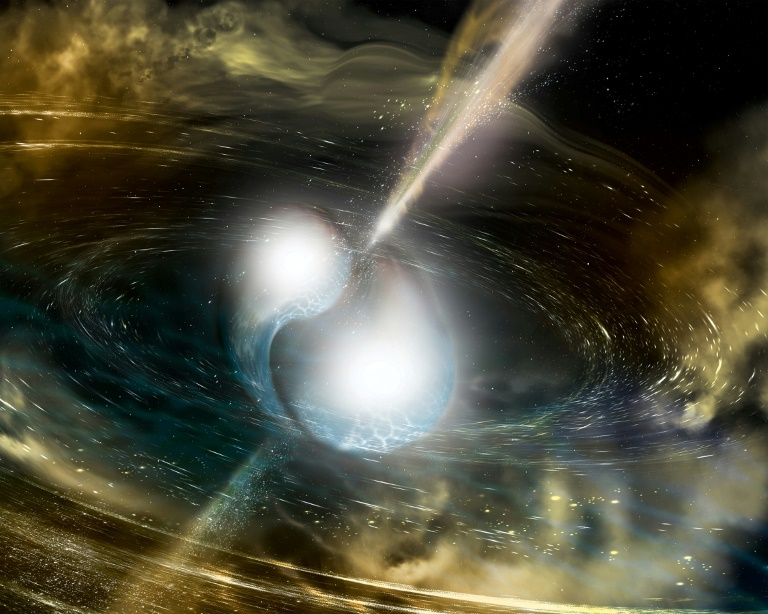Science
Astronomers Uncover Origins of Fast X-ray Transients from Supernova

A groundbreaking discovery has linked fast X-ray transients (FXTs) to the explosive death of a massive star, specifically a supernova. This cosmic event, observed by an international team led by researchers from Northwestern University and the University of Leicester, marks the closest FXT ever detected, situated approximately 2.8 billion light-years from Earth within the constellation Eridanus. The findings shed light on the enigmatic origins of FXTs, which have puzzled astronomers since they were first identified in the 1970s.
The team utilized various telescopes across the globe and in space to study FXTs, revealing that the emissions are generated by jets of high-energy particles trapped within the outer layers of a dying star. These jets, when successful, produce gamma-ray bursts (GRBs), the most powerful explosions known in the universe. However, when these jets fail to break through the star’s outer layers, they emit lower energy signals detectable as X-rays. This new insight provides a potential explanation for the elusive nature of FXTs.
Significant Observations and Discoveries
The research was fuelled by the launch of the Einstein Probe in January 2024, a collaborative effort by the Chinese Academy of Sciences, the European Space Agency, and the Max Planck Institute for Extraterrestrial Physics. The probe is equipped with advanced instruments specifically designed to observe X-ray sources. Shortly after its launch, it captured the FXT designated as EP 250108a, providing an unprecedented opportunity for astronomers to monitor its evolution.
The FXT EP 250108a is linked to a supernova known as SN 2025kg, humorously referred to as “the kangaroo.” Over several weeks, the supernova’s brightness increased before fading, allowing the scientific team to confirm it as a broad-lined Type Ic supernova, typically associated with highly energetic phenomena like GRBs. Intriguingly, no evidence of a GRB was detected in this case, leading researchers to conclude that EP 250108a represents a “failed” GRB.
The team employed multiple observatories to gather data, including the FLAMINGO-2 spectrograph on the Gemini South telescope, the W.M. Keck Observatory in Hawaii, and the James Webb Space Telescope. Each contributed valuable insights into the characteristics of the supernova and its associated FXT.
Linking FXTs to Supernovae
Through meticulous analysis, scientists estimate that the progenitor star responsible for EP 250108a had a mass ranging from 15 to 30 times the mass of the Sun. The research supports a causal link between GRB-supernovae and FXT-supernovae, distinguishing between successful jets that produce GRBs and weaker jets that result in FXTs.
Two companion studies detailing various aspects of this phenomenon have been accepted for publication in The Astrophysical Journal Letters. The first study, titled “The kangaroo’s first hop: the early fast cooling phase of EP250108a/SN 2025kg,” focuses on the early stages of the FXT, while the second, “EP 250108a/SN 2025kg: Observations of the most nearby Broad-Line Type Ic Supernova following an Einstein Probe Fast X-ray Transient,” elaborates on the findings related to the supernova itself.
This discovery not only enhances our understanding of cosmic events but also illustrates the potential of new observational technologies in unraveling the mysteries of the universe. As astronomers continue to explore these phenomena, the collaboration among international teams and advanced telescopes will likely yield even more profound insights into the life cycles of massive stars and their explosive endings.
-

 Science3 months ago
Science3 months agoToyoake City Proposes Daily Two-Hour Smartphone Use Limit
-

 Top Stories3 months ago
Top Stories3 months agoPedestrian Fatally Injured in Esquimalt Collision on August 14
-

 Health3 months ago
Health3 months agoB.C. Review Reveals Urgent Need for Rare-Disease Drug Reforms
-

 Technology3 months ago
Technology3 months agoDark Adventure Game “Bye Sweet Carole” Set for October Release
-

 World3 months ago
World3 months agoJimmy Lai’s Defense Challenges Charges Under National Security Law
-

 Lifestyle3 months ago
Lifestyle3 months agoVictoria’s Pop-Up Shop Shines Light on B.C.’s Wolf Cull
-

 Technology3 months ago
Technology3 months agoKonami Revives Iconic Metal Gear Solid Delta Ahead of Release
-

 Technology3 months ago
Technology3 months agoApple Expands Self-Service Repair Program to Canada
-

 Technology3 months ago
Technology3 months agoSnapmaker U1 Color 3D Printer Redefines Speed and Sustainability
-

 Technology3 months ago
Technology3 months agoAION Folding Knife: Redefining EDC Design with Premium Materials
-

 Business3 months ago
Business3 months agoGordon Murray Automotive Unveils S1 LM and Le Mans GTR at Monterey
-

 Technology3 months ago
Technology3 months agoSolve Today’s Wordle Challenge: Hints and Answer for August 19









